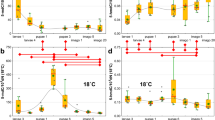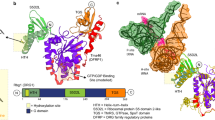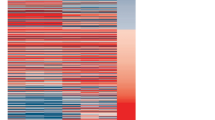Abstract
The insect Drosophila melanogaster belongs to an atypical group of animals with no detectable genomic 5-methylcytosine1,2,3. We found, unexpectedly, that the Drosophila genome potentially encodes two proteins that resemble a cytosine DNA methyltransferase and a mammalian methyl-CpG-binding-domain (MBD) protein, respectively. The hypothetical DNA methyltransferase, dDNMT, is closely related to the pmt1/DNMT2 family identified in fission yeast4 and mouse5,6 (Fig. 1a). Attempts to transfer methyl groups from S-adenosylmethionine to DNA have not been successful using native members of this family, and bacterially expressed dDNMT was catalytically inactive in vitro (data not shown). Although the dDNMT transcript is present in embryonic, larval and adult flies (data not shown), the functional significance of the protein is unknown. Our report focuses on the Drosophila protein dMBD2/3, which is related to MBD2 and MBD3 of mammals7 (Fig. 1b). We detected two transcripts encoding dMBD2/3 in Drosophila cultured-cell RNA, 0-hour to 4-hour embryonic stages and adults, suggesting widespread expression of the gene (data not shown). The shorter splice variant lacks part of the methyl-CpG-binding-domain homology (dMBD2/3Δ; Fig. 2f; ref. 8, and data not shown).
This is a preview of subscription content, access via your institution
Access options
Subscribe to this journal
Receive 12 print issues and online access
$209.00 per year
only $17.42 per issue
Buy this article
- Purchase on Springer Link
- Instant access to full article PDF
Prices may be subject to local taxes which are calculated during checkout


Similar content being viewed by others
References
Tweedie, S., Charlton, J., Clark, V. & Bird, A. Mol. Cell. Biol. 17, 1469–1475 (1997).
Urieli-Schoval, S., Gruenbaum, Y., Sedat, J. & Razin, A. FEBS Lett. 146, 148–151 (1982).
Bird, A.P. & Taggart, M.H. Nucleic Acids Res. 8, 1485–1497 (1980).
Wilkinson, C.R.M., Bartlett, R., Nurse, P. & Bird, A.P. Nucleic Acids Res. 23, 203–210 (1995).
Yoder, J.A. & Bestor, T.H. Hum. Mol. Genet. 7, 279–284 (1998).
Okano, M., Xie, S. & Li, E. Nucleic Acids Res. 26, 2536–2540 (1998).
Hendrich, B. & Bird, A. Mol. Cell. Biol. 18, 6538–6547 (1998).
Wade, P.A. et al. Nature Genet. 23, 62–66 (1999).
Zhang, Y. et al. Genes Dev. 13, 1924–1935 (1999).
Ng, H.-H. et al. Nature Genet. 23, 58–61 (1999).
Kehle, J. et al. Science 282, 1897–1899 (1998).
Wharton, K.A., Yedvobnick, B., Finnerty, V.G. & Artavanis-Tsakonas, S. Cell 40, 55–62 (1985).
Barbin, A. et al. Hum. Genet. 94, 684–692 (1994).
Kumar, S. et al. Nucleic Acids Res. 22, 1–10 (1994).
Nan, X. et al. Nature 393, 386–389 (1998).
Meehan, R.R., Lewis, J.D., McKay, S., Kleiner, E.L. & Bird, A.P. Cell 58, 499–507 (1989).
Acknowledgements
We thank J. Müller for the dMi-2 plasmid; V. French for crickets; D. Finnegan for fly DNA; D. Macleod for comments on the manuscript; and J. Charlton, V. Clark, A. Greig and J. Davidson for technical assistance. This work was supported by grants to A.B. and B.M.T. from the Wellcome Trust. H.-H.N. is a Darwin Trust Scholar.
Author information
Authors and Affiliations
Corresponding author
Rights and permissions
About this article
Cite this article
Tweedie, S., Ng, HH., Barlow, A. et al. Vestiges of a DNA methylation system in Drosophila melanogaster?. Nat Genet 23, 389–390 (1999). https://doi.org/10.1038/70490
Issue Date:
DOI: https://doi.org/10.1038/70490
This article is cited by
-
DNA N6-methyladenine in metazoans: functional epigenetic mark or bystander?
Nature Structural & Molecular Biology (2017)
-
Cytosine methylation is a conserved epigenetic feature found throughout the phylum Platyhelminthes
BMC Genomics (2013)
-
Epigenetics and its implications for ecotoxicology
Ecotoxicology (2011)
-
Sex-specific methylation in Drosophila: an investigation of the Sophophora subgenus
Genetica (2010)
-
Retrotransposon silencing and telomere integrity in somatic cells of Drosophila depends on the cytosine-5 methyltransferase DNMT2
Nature Genetics (2009)



